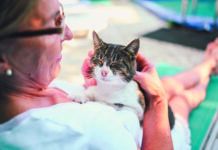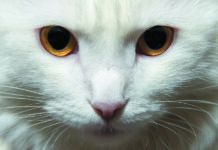Help for Carpal Hyperextension
Q: My ten-year-old female cat was recently diagnosed with carpal hyperextension in one of her front paws. I am reluctant to have the surgery performed on her, and there is currently no medication that can help the condition.
Thankfully, she is able to deal with it — with just a minor change in gate — and there is no swelling so far and she is able to jump onto low places. I would love to hear if the veterinarians at Tufts have any updated information on this condition. – Ann Silvers
A: Dear Ann: For readers that may be unfamiliar with this condition, hyperextension injury is a ligamentous injury to the carpus (wrist joint) of the front limb. It typically occurs due to a jump from a height or other trauma. The front limb is weight bearing in the cat, unlike the arm in humans.
Unfortunately, once a ligamentous injury has occurred, substantial healing cannot occur because daily weight-bearing forces continuously disrupt any attempts at healing.
Medication, bandaging or splinting is not successful, since the healed ligament never attains the necessary strength. Surgical fusion (arthrodesis) of the wrist joint is the best treatment option; following successful fusion, weight-bearing force and function are normal or close to normal.
Michael P. Kowaleski, DVM, DACVS
Professor of Orthopedic Surgery
Cummings School of Veterinary Medicine at Tufts University
New Cat with a Huge Appetite
Q: We recently adopted a two-year-old male cat, and he’s been a delightful addition to our household (we have two resident cats, who we raised from kittenhood). Bucky lived at some point as a homeless cat — maybe abandoned, no one knows for sure. But a kindly person noticed him in a feral colony where he was fed for about a month (and he was clearly not a feral stray), and then she set about finding him a proper home.
Here’s the problem: He scarfs down his meals like there is no tomorrow. Our other two cats are more leisurely in their approach to mealtime, eating a little bit here and there and leaving some for later. But not Bucky! I tried to see how much he would eat in one day (during the time he was kept separate from the others, before the true introduction) — and there is not a morsel of food he will refuse.
His health is good (he was neutered and vaccinated shortly before we adopted him). Is this a behavioral issue that was caused by his living on the city streets for a little while? And how can we be sure that the three cats get equal opportunity at mealtime? My husband and I have busy schedules, and would prefer to find a logical and somewhat convenient way to approach this problem (and not make feeding them separately a part-time job in itself!). Any advice would be much appreciated. – Donna Richmond
A: Dear Donna: A lot of animals — cats included — that have had a difficult time finding enough to eat when living in a feral community-type setting become ravenous when they are presented with regular meals in an adoptive home. It’s as if they have to scarf down all the food as fast as possible to avoid having others share in their windfall. Even when alone, they don’t want to take any chances. In my experience, the almost depraved feeding frenzy that their inner panic creates take about a year to dissipate. It takes that long for them to learn that there’s more where that came from.
Of course, it is also possible that your new addition has some medical issue contributing to the gourmand nature of his ingestive behavior. Diabetes and hyperthyroidism are two conditions that cause polyphagia (increased appetite) and should be ruled out by your vet before jumping to my more purely behavioral explanation.
Nicholas Dodman, BVMS
Animal Behavior Clinic Director
Cummings School of Veterinary Medicine at Tufts University
Indoor Cat Wants to Go Outside
Q: I have a wonderful five-year-old cat that rescued from the streets when she was a kitten. This year, she has decided to drive me crazy by going from one door to the other and meowing constantly. She is not allowed out in my apartment complex and has not really given me much trouble — until now.
In these five years, she has never acted like this. I tried walking her on a leash, but the experience was disastrous. She doesn’t play with cat toys, so my veterinarian suggested that I adopt a kitten. I hesitate on this, but will wait for your reply. I’ve had more than one cat at a time, so I think I know what to expect, but at 80 years old, I have some doubts! My cat is a very high-strung, nervous cat; she hides when anyone comes to my house. Any help you can give me will be more than appreciated. – Frances Hunt
A: Dear Frances: It does seem that your cat has suddenly heard the call of the wild and wants to be outside again as, no doubt, she once was. Why she waited this long to express her frustration with the indoor life is a mystery to me — though springtime, with all its outdoor goings on, is always a key time for cats’ wanderlust to be titillated.
The fact that your cat’s spring fever has taken four years to emerge, however, makes me wonder if something outside has recently changed to attract her attention. Perhaps a new neighborhood tomcat has been giving her the eye, or a bird has made a nest in a nearby tree or bush. We may never know. Your veterinarian’s suggestion of getting another cat is not a bad idea as it would help divert some of your cat’s attention and energies.
Alternatively, you could try enriching her indoor environment with climbing frames or hidey holes, while at the same time attenuating her visual access to the outdoors by screening off windows. Toys are helpful to occupy her days, food puzzles are especially good, and you should exercise her for at least 30 minutes daily by getting her to chase moving things (such as feathers on a string).
While it is definitely safer for cats to be kept indoors, especially these days, indoor cats must be directly or indirectly entertained or they will go stir crazy. I wish you luck in satisfying your cat’s inner cat, restoring peace to your household.
Nicholas Dodman, BVMS
Animal Behavior Clinic Director
Cummings School of Veterinary Medicine at Tufts University



